Porcelain Insulator News
by Elton Gish, NIA #41
Reprinted from "Crown Jewels of the Wire", December 1990, page 20
Jack Tod started editing the Porcelain Insulator News column in November,
1971. He continued as editor until his last column appeared in the June, 1984
issue. Early in 1984, Jack asked me to take over his job as editor. I was very
shocked at his request. I had always looked to Jack for the answers to my
questions. With his encouragement, I did agree to give it a try. So, in July,
1984, I started editing Jack's column and the rest is history.
Many of you knew
Jack well. I began corresponding with him in 1973 after finding a lot of
interesting trade journal articles from the 1890's at the local university
library. Several of them proved to be of great value to Jack in his research of
the early porcelain companies. That was hundreds of letters ago. We became very
good friends even though I had only met him once at the 1973 Hutchinson National. Our next meeting was at the 1988 Eastern Regional in Nashville with
the third and last meeting at the 1988 Houston National. He drove the extra 100
miles to my house the next day to see my collection. It has always amazed me
that friends are easily made in our hobby with little or no face-to-face
meeting. It was that way with Jack. He was always available with answers to
questions. It seems he relished the chance to instruct or inform, writing
detailed letters and never at a loss for an opinion. I kept all of Jack's
letters. Hundreds of pages filled with the fruits of his years of experience.
Each letter is so distinctively Jack. Many times a simple answer turned into 3-4
typed pages.
At Nashville in 1988, Jack explained why my lucky number 13 was
taken away from me that night in 1973 at the Hutchinson National. My NIA membership number was 13 for a few fleeting minutes, then quickly snatched out of my
hand with a simple "...sorry, that number is for someone else. Who?? Why??
I ended up with #41. Jack surprisingly explained, after all these years, that he
had requested 13 that historic night when the NIA was formed. That coincidence
was overshadowed when I learned that Jack had died on my first wedding
anniversary. In memory of Jack and his contributions, I dedicate this month's
Porcelain Insulator News. We miss you, Jack.
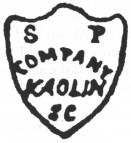
I recently received an inquiry regarding the Southern Porcelain Co. of
Kaolin, South Carolina. In the book, Marks of American Potters, a reference is
made that the Southern Porcelain Co."...manufactured Parian and fine white
china to a limited extent between 1856 and 1862. They also made brown stoneware telegraph insulators." Could this be the manufacturer of the
Confederate teapot (U-990), the slash top (U-988) and the egg (U-970)? I would
appreciate hearing from anyone who may have additional information. Southern
Porcelain used the incuse marking shown above on their china ware.
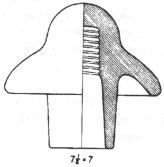
In Porcelain Insulator News in the December, 1988 and April, 1989 issues of CJ, we talked about the mushroom-shaped "whatisit" insulator shown
above. I did find one reference to this insulator in the 1926-27 Ohio Brass
catalog. A picture from this catalog was shown in the April issue which shows
the arrangement like the photo sent in by Vincent Yeasted (shown below). Little
information was in the catalog regarding this insulator other than the reference
that it was part of an "Ohio Brass flux [corona] control."
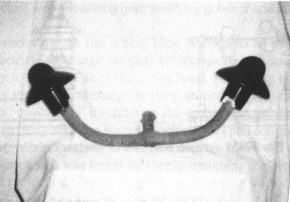
Otto Boll sent Xerox copies of a few pages from his Ohio Brass catalog No.24
(circa 1940). The drawings (reproduced on next page) do show another use for the
"mushroom" insulator. Keep in mind that this arrangement is different
than that shown in the photo by Vincent Yeasted and used on the bottom of
suspension strings. This arrangement was called "O-B Control Gaps".
Control gaps provided equipment protection from direct lightning strokes at
substations. Below is a quote from the Ohio Brass catalog description:
"The fast action of O-B control gaps is obtained through the ingenious
design of the electrodes and shielding, a design which combines the desirable
characteristics of both rod and sphere gaps. A relatively uniform dielectric
field is obtained by means of porcelain insulated electrodes surrounding the
arcing terminals. These control electrodes are so placed that while they
increase the effective electrode areas, they are insulated to prevent flashovers
at other than the arcing terminals.
The selected protection level of the gap
will remain unchanged indefinitely as porcelain is the only dielectric
material used and a controlled air gap is the only resistance or impedance
placed in the discharge circuit."
Note that there was a short skirt version shown in one of the drawings. This
idea must have had a very limited use as it was not shown in other O-B catalogs.
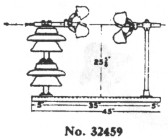 |
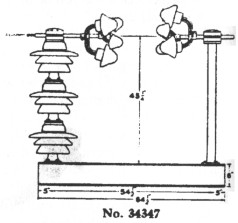 |
|
Ohio Brass "Control Gaps" |
On a recent trip to the local university library, I was doing some quick
research in the "Official Patent Gazette". While flipping through the
pages of the September, 1925 volume, a patent drawing caught my eye. Now this
was my lucky day! It was the patent for the "mushroom" insulator! ! !
The patent described in detail the use of this insulator as part of an
'insulated flux control" system for controlling the electrostatic flux
distribution of a suspension string. The four pages of drawings with the patent
show various forms of the "mushroom" insulator, some with metal
caps. All of the drawings (two pages of patent drawings shown on the next two
pages) show multiple or multipart insulating "caps". while the exact
style of the "mushroom" insulator is not shown, this patent does
indeed describe the purpose of the "mushroom" insulator.
There was a
reference to a prior patent application for a "single insulating
cover". Finding that patent, if it was ever granted, may be difficult since
I do not know if a patent was granted, or when it was granted. I will continue
to search for that one in the future and keep you updated if I am successful in
locating it.
This patent is 1,552,664 granted to Arthur O. Austin and assigned
to the Ohio Brass Co. The patent text only refers to application to suspension
insulator strings. The use in "control gaps" may have been covered by
another patent. This patent may have been the first design of arcing horns which
were cataloged by all companies from the 1920's to at least the 1940's. Arcing
rings were first introduced in 1910 by Nicholson for use with M-3890 on the line
from Niagara to Syracuse, NY.
In brief, this patent states that the metal horns
with insulator caps constitute flux distributing members which serve to regulate
the electrostatic gradient in the main string of suspension insulators. In other
words, the suspension string would have a higher voltage at the bottom where it
is attached to the conductor and a lower voltage where it is attached to the
tower. During voltage surges such as a lightning strike nearby, arcing across
the suspension string may result in damage to the suspension insulators. The
voltage difference across the string could be lessened with the arcing horn
resulting in fewer and less damaging arcs.
The insulated caps on the arcing horn
were used to provide added security against electrical discharge (arcing) by
increasing the insulation. This seems contradictory to the purpose of the arcing
horn. The arcing horns are like electrodes, allowing the electrical charge to
jump around the suspension insulators. By placing the "mushroom"
insulator on the end, would reduce the chance of arcing. This system may not
have been very effective. I can see problems with puncturing of the porcelain
insulator or extreme damage to it from a single arc. Obviously, a better
approach was found by simply designing the arcing horns to achieve the desired
protection. The catalogs show dozens of such designs.
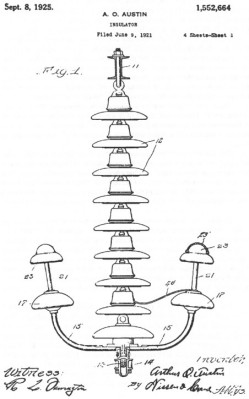
Medium Image (57 Kb)
Large Image (112 Kb)
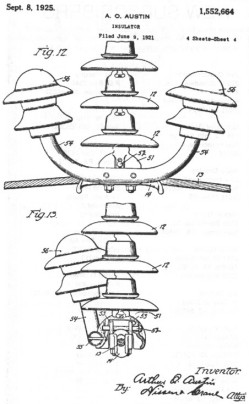
Medium Image (72 Kb)
Large Image (142 Kb)
| 